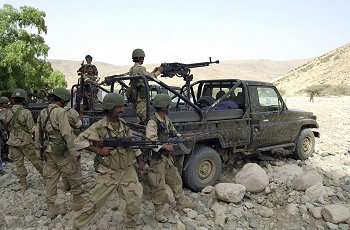
Yemeni soldiers patrolling in Saada, 150 miles north of the capital, Sana’a. A Yemeni Member of Parliament accused of being a leader of a deadly three-year uprising by the Zaidi minority in the northern mountains warned in remarks published on Feb. 25 that rebels might widen their campaign. (Photo: Khaled Fazaa / AFP-Getty Images)
Integrated Regional Information Networks, United Nations, May 6, 2007
The I.C.R.C. and Red Crescent came under attack in the Saada region of northern Yemen. (Photo: Afif Sarhan / IRIN)
A humanitarian aid convoy of the International Committee of the Red Cross (I.C.R.C.) and the Yemen Red Crescent Society came under heavy gunfire on May 2 in the governorate of Saada, north Yemen, the I.C.R.C. has reported.
The incident took place in al-Saifi area, 18 kilometers north of Saada city.
Fighting between government forces and followers of rebel leader Abdul-Malik al-Houthi in Saada governorate is still going on, causing thousands of people to leave their homes, said aid workers.
Iman Mo’anqar, an I.C.R.C. spokesperson in Sanaa, told IRIN the convoy consisted of 15 trucks carrying aid supplies for 560 displaced families (about 3,900 people). One I.C.R.C. staff member and 40 Yemeni Red Crescent volunteers accompanied the convoy whose vehicles were marked with the Red Crescent emblem, she said.
“Two aid volunteers were slightly injured and sent to hospital for treatment,” she said, adding that the I.C.R.C. has no information as to why the convoy was attacked.
Saada Conflict
The conflict began in June 2004 when Hussein Badr al-Din al-Houthi, Yemen’s head of the Zaidi sect of Shia Islam, led a revolt against the government.
Al-Houthi followers—known as Shabab al-Mu’minoon (Believing Youth)—espouse anti-American and anti-Israeli sentiments, accusing the Yemeni government of kowtowing to the United States.
The government, which is led by a Zaidi president although the country has a Sunni majority, accuses them of being “terrorists” as they seek to reinstall the Zaidi Imamate regime, which was overthrown in 1962.
The Believing Youth refute this. Beyond toppling a government they abhor, the aims of the Believing Youth are not entirely clear. The conflict encompasses religion, politics, and tribal affiliations.
From June to August 2004, al-Houthi followers (estimated to number 3,000) fought against government troops. Estimates of the dead range from 80 to 600.
Most of the fighting has taken place in Saada province, in the northwest of Yemen.
Al-Houthi was killed in September 2004, leaving his father, Abdul Malik al-Houthi, to take over leadership of the uprising.
In a resurgence of fighting in March and April 2005, more than 200 people were killed.
In May 2005, the government said that the internal conflict was responsible for 552 deaths, close to 3,000 injuries and $270 million in economic damage.
A new spate of fighting broke out in December 2006.
In February 2007, the government launched a major offensive against the rebels involving 30,000 troops.
To date, hundreds of fighters have been killed on both sides and up to 35,000 civilians displaced.
“This attack jeopardizes vital humanitarian work. The I.C.R.C. condemns all attacks on civilians, including humanitarian workers,” the I.C.R.C. said in a statement, “Under international humanitarian law, all those engaged in relief work must be respected and protected.”
Civilians Dying
Fighting between government forces and rebels is also causing deaths among civilians and threatening to provoke a humanitarian crisis as many become displaced.
Government forces have not been able to suppress the rebellion despite recruiting thousands of tribesmen to back them in the mountainous areas of Saada. The government has also turned to religious scholars and mosque preachers for help.
Houthis are Shia rebels who follow the Zaidi doctrine and are a minority in the country. The government accuses them of being “terrorists” as they seek to reinstall the Imamate regime, which was overthrown in 1962.
Communications Cut Off
The Civil Society Coalition (C.S.C.), a group of local N.G.O.’s, last month condemned the war in Saada. It said scores of people, including civilians on both sides, are dying every day, and it was worried about thousands of displaced people who cannot get assistance.
C.S.C. said it was difficult to monitor the fighting because of problems accessing the region. Communications with the region have been cut off, thus preventing journalists and rights groups from getting information on the hostilities, “which makes the fate of victims of the fighting unknown.”
The C.S.C. has asked the authorities to resort to peaceful means to end the rebellion, explain the reasons for the war, and stop detaining people.
Over 30,000 Displaced
The I.C.R.C. office in Sanaa estimates that between 30,000 and 35,000 people have abandoned their homes and are now living in precarious conditions, the majority of them staying with host families.
“The I.C.R.C. is concerned about the fate of civilians who are affected by the armed confrontations in the region of Saada,” the I.C.R.C.’s Iman said.
According to her, the I.C.R.C. has so far provided 3,272 families (each family has about seven members) with emergency aid, including tents, groundsheets, jerry cans of water, mattresses, blankets, and soap.
“The I.C.R.C. has installed three water tanks which are filled every second day and cover the daily needs of the internally displaced persons. In the same location, the I.C.R.C. has built 24 latrines—half for the use of women only,” she added.
Fighting between government forces and al-Houthi followers in ‘Saada first broke out in 2004. Fierce clashes at intervals over the past three years have claimed the lives of more than 700 government forces and wounded about 5,300, say humanitarian workers. © IRIN
[This report does not necessarily reflect the views of the United Nations]
For more posts on the al-Houthi rebellion, click here and here.